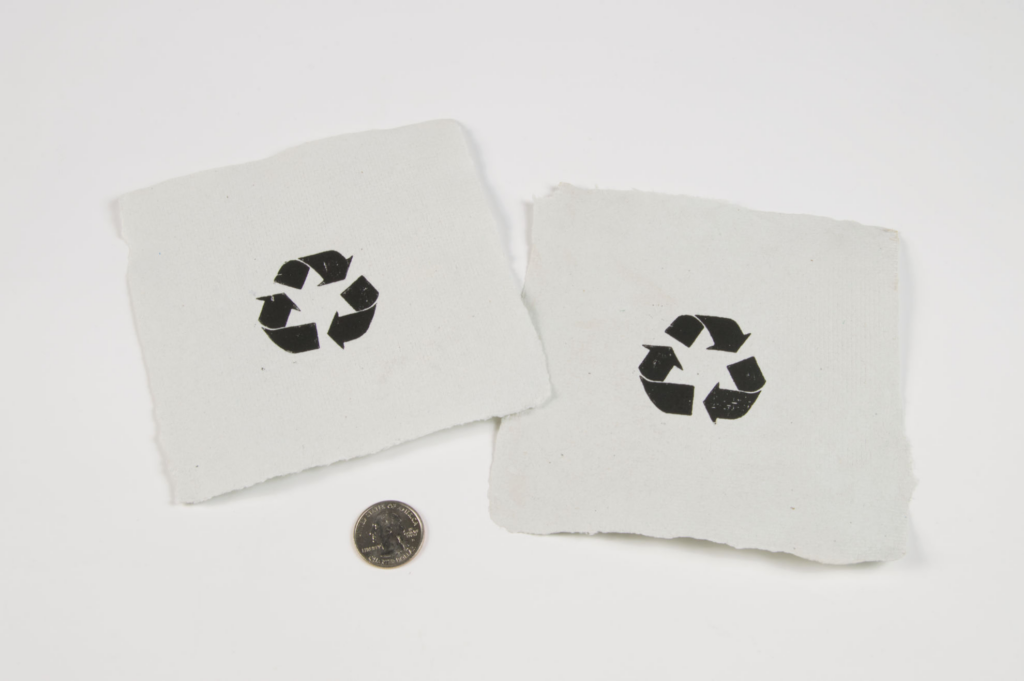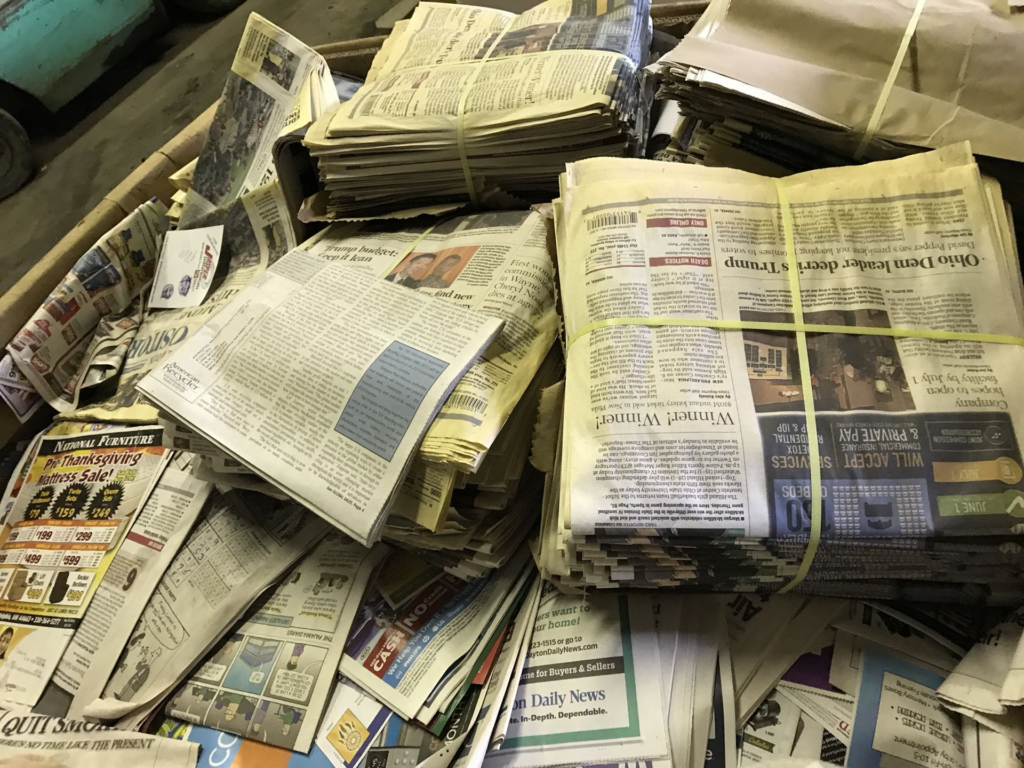Last Updated on January 25, 2025 by Packoi Team

The special nature of recycled paper also gives its printing a certain particularity. Not every type of paper recycling process for printing can complete the printing of recycled paper in high definition.
Today, let’s explore how to print recycled paper in an environmentally friendly way. Make our recycled paper more sustainable!
Types of Recycled Paper
Recycled paper, a sustainable printing option, comes in various types, each with its own characteristics and uses. It is a great choice of eco-friendly options for environmentally conscious individuals looking to reduce their environmental impact on the planet. Here are the different sustainable printing options now available on the market:
- Post-consumer recycled paper is a sustainable printing option made from materials that have already been used by consumers and collected for recycling. This type of recycled paper is ideal for environmentally conscious individuals looking for eco-friendly printer options. It includes items like newspapers, magazines, and office paper. Post-consumer recycled paper is widely used for printing documents and promotional materials using a printer.

- Pre-consumer recycled paper is an excellent choice for sustainable printing. Unlike post-consumer recycled paper, this paper is unused waste generated by the printer during the manufacturing process and can be recycled. These scraps are collected and turned into new paper products. Using pre-consumer recycled paper helps reduce waste in the production cycle while maintaining quality.
- Specialty papers: In addition to post-consumer and pre-consumer recycled paper, there are specialty papers made from industrial waste, agricultural waste, or specific materials such as bamboo. These papers offer unique properties and can be used for specialized purposes like packaging, labels, or artistic projects.
Understanding the different types of printing paper available is crucial. Whether you choose post-consumer or pre-consumer recycled paper products or opt for specialty papers made from alternative materials, each option contributes to a more sustainable printing paper industry everywhere.
So next time you need to print something, consider using just one sheet of these types of recycled papers to make an environmentally conscious choice without compromising on quality or style!
Difficulties in Printing Recycled Paper
Printing on recycled paper can pose some unique challenges that must be addressed in order to ensure the best results. Here are some common difficulties that can arise when printing on recycled paper:
Inconsistent Quality
Recycled paper can vary in quality, making it difficult to predict how the scrap paper will perform on the printing press. This can result in inconsistent print results, including uneven ink coverage and ghosting.

Higher Moisture Content
Recycled paper often contains higher levels of moisture than virgin paper, which can cause issues during printing and processing. The paper may absorb too much ink, causing the ink to smear or bleed onto white paper, or the paper may buckle or warp during processing, leading to poor page registration and alignment.
Increased Wear and Tear on Printing Equipment
Recycled paper can cause increased wear and tear on printing equipment, particularly in high-speed systems. This is because the higher levels of moisture and contaminants in the recycled paper can lead to increased wear and tear on the plates, rollers, and other components of the printing press.
Limited Options for Paper Finishing
Recycled paper can also be more difficult to finish than virgin paper. For example, it may not be suitable for some types of finishing processes, such as laminate coating or UV coating, due to its higher moisture content or other physical properties.
Despite these challenges, printing on recycled paper has many environmental benefits, too, including significantly reduced waste, conservation of natural resources, and a more sustainable environmental impact for paper manufacturers. With the right preparation and execution, printing on recycled paper can deliver high-quality results while contributing to a more sustainable future.
How to Print Recycled Paper Efficiently
To print recycled paper efficiently, it’s important to address the unique challenges that come with printing printed material on recycled paper. Here are some tips to help you print printed materials on recycled paper efficiently:
Choose the Right Paper
Recycled paper comes in different qualities, so it’s essential to pick the right one for your printing needs. Consider the intended use, size, finish, and other factors when making your selection.

Optimize Print Settings
Recycled paper often requires different print settings than virgin paper, so it’s important to optimize your settings to get the best results. This may include reducing print speeds and/or increasing pressure to prevent ghosting or other printing issues.
Test Print
Before launching a full-scale print project, it’s essential to test print your materials to ensure you have the right settings and quality control processes in place. This can help you identify and fix any issues before they impact a larger project.
Invest in Quality Printing Equipment
Quality printing equipment is essential for printing recycled paper. Look for printers that can handle high volumes of paper, are designed for speed and accuracy, and have features such as moisture sensing and ink density monitoring to help you optimize your environment and prints.
Train Your Team
Ensure your staff has the necessary training to print on recycled paper efficiently, including knowledge of the unique print settings, quality control procedures, and other factors that impact print quality.
Monitor Print Quality
Regularly check print quality to ensure it meets your standards, making any necessary adjustments as needed. This can help you catch and fix problems before they impact your final product.
Plan for Downtime
Recycled paper can be more difficult to print than virgin paper, so it’s important to plan for potential downtime during printing. This can help minimize any impacts on your paper production and schedule and ensure you’re prepared for any unexpected challenges that may arise.
By following these tips, you can print recycled paper efficiently, delivering high-quality results and contributing to creating a more sustainable future.
Environmentally Friendly Printing Solutions for Recycled Paper
Printing with recycled paper is an environmentally friendly printing solution that can help reduce waste, conserve natural resources, and minimize the carbon footprint of printing operations. Here are some additional ways to make your business cards’ own paper recycling and paper printing even more environmentally friendly:
Use LED Printing
LED printing is a sustainable alternative to traditional laser printing, which uses less energy and produces less waste. LED printers also typically produce better print quality, making them a great choice for high-quality print projects.
Reuse Printable Materials

Instead of throwing away unused paper stocks or printing materials, consider repurposing them for other creative projects. You can also donate excess paper stocks or materials to local schools, art programs, or other organizations that can make use of them.
Reduce Paper Usage
Print double-sided whenever possible to reduce paper waste, and look for ways to minimize paper usage in your printing processes. This may include using smaller paper sizes, reducing the use of headers and footers, or converting materials to digital formats where possible.
Print-On-Demand
Consider implementing on-demand printing solutions, which allow companies and you to print only what you need when you need it. This can help minimize waste and reduce the need for bulk printing.
Use Eco-Friendly Inks and Toners
Look for printed inks and toners from recyclable products certified by environmental organizations such as FSC or LEED that use fewer harmful chemicals. Compared with solvent-based inks, vegetable oil inks have a lower viscosity, are more stable, and are more suitable for printing recycled paper. It just takes longer, but you can get high-quality prints.
Print with Fewer Colors
Consider using fewer color-based inks or soy-based inks in your printing projects to reduce waste and lower your energy costs. Print jobs that only require black and white or two colors can still produce high-quality results, making them a great choice for sustainability.
Invest in Waterless Printing
Waterless printing removes the need for water-based ink and toner, reducing power consumption, reducing the potential for water pollution, and maximizing efficiency. This is how green printing can be a sustainable and cost-effective solution for high-volume printing projects.
By implementing these environmentally friendly printing solutions, you can reduce your company’s impact on the environment, minimize waste, lower energy costs and carbon emissions, and create more sustainable printing operations.
Discover the Perfect Solution for Your Business with Packoi Printing
Congratulations! You now know about using recycled paper for environmentally friendly printing. Now is the time for action. Embrace sustainable and environmentally responsible practices by choosing Packoi Printing as your eco-friendly printing partner.
Packoi Printing is an FSC-certified packaging printing company, and we can help you create amazing printing materials while minimizing your impact on the environment.
So why wait? Start making a positive difference for future generations of the paper industry today and join the countless businesses that have already switched to environmentally friendly printing. Contact us!




